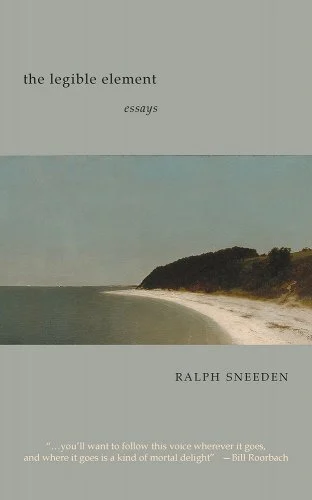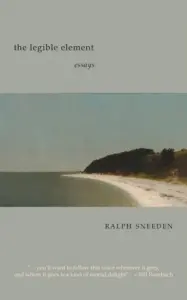By RALPH SNEEDEN
Reviewed By MATT W. MILLER
Narratively driven and lyrically evocative, The Legible Element by Ralph Sneeden is a collection of personal essays that threads stories of surfing, sailing, teaching, fishing, and even pond hockey through deep meditations about adolescence, fatherhood, marriage, family, aging, and the natural world. A kind of memoir-in-essays, the book uses these experiences and the vehicle of the “I” as a way to explore a life lived by and for water.
The nineteen essays that make up The Legible Element, from the almost flash length of the title essay to the brilliant 60-page “Immersion Notes,” reach into the writer’s past but do not languish in sepia-washed nostalgia. They take a clear-eyed look at how Sneeden’s experiences have shaped his life and how and why he sees the world; the stories are ever in service to the subjects of the essays. Nevertheless, one of the great joys of the reader is sure to be a wistful look back at a particular kind of American youth that no longer exists, one where kids double ride bikes, search out the safe ice for pond hockey, or where four teenage boys could take a boat across a stretch of water to sneak into a showing of the Exorcist without GPS to guide them and without being tracked by parents through their phones. In these stories we see the lightly dangerous but deeply thrilling adventures of youth we have abdicated with all of our baby-proofed corners, playdate culture, and the swallowing vortex of screens and social media.
A finalist for the Walt Whitman Award, The Yale Series of Younger Poets, and recipient of the Friends of Literature Prize from POETRY magazine, Sneeden is a poet and author of two collections of poetry, Evidence of the Journey and Surface Fugue. It’s no coincidence, then, that what strikes first about this collection is the attention to language—how language makes a place just as the place makes the language. Writing largely about and through the coastal enclaves of Massachusetts, New Jersey, and California, Sneeden employs and even deploys the vernacular particular to the people and land of these environments. With a poet’s tongue and a painter’s eye, Sneeden immerses us deeply in the physical environments of his experiences, both the natural ecology and the often-unnatural human ecologies that elbow at each other for survival:
“In the lee of the eastern shore, there is barely a ripple, and the canoe glides easily along partially submerged spartina bristling at the foot of the bluff’s tonsure. The tide is on its way in, about halfway there. Off the boatyard, all moored hulls obey the current, their noses oriented toward the bay. Once I swing around the point and into the wind, the bear cub cry of morning leaf blowers harmonizing with the whine of outboards is muted.”
The richness of image, the deliberation on not just what words mean but how they make meaning through sound is a constant and alluring presence in this collection. As well, moments such as “all moored hulls obey the current” show Sneeden’s light but sure hand at using images to construct subtext and figurative meaning. When recounting trying to paddle out on a surfboard though a ferocious shore break, Sneeden writes, “By the time you have punched through and ducked under all the disorienting waves bent on sweeping you right back to shore and two hundred yards down the beach, you’ve had enough,” showing us the physical task of surfing while also drawing a parallel to the Sisyphean task that this life can too often seem.
But the essays are not brooding nor nihilistic in tone. Even as ice and sea threaten to swallow there is ever the impish Yankee humor undercutting any gloom or self-pity. Sneeden, whether talking waves or poetry, is never pedantic, never flexing knowledge about water or literature. He’s just excited to make connections between ideas, fully and puckishly aware of his geeky literariness, acknowledging that “Nothing, I am told, is more boring than when I do start talking about the waves, harpooning dialogues with a tour guide’s gesticulations.”
And yet when he does talk of waves, he somehow, to borrow from Pound, makes them new. In the title essay of the collection, Sneeden writes of his life lived studying ocean waves through his discovery of a passage about waves by poet Gerard Manley Hopkins:
“Hopkins’ exegesis of surf is untainted, almost clinical in its syntactical breakdown of the physical wave’s breaking process, its variation of color and architecture. His notes on waves are a field sketch, a quick plein air watercolor with words, but one with a restrained riptide of joy and connection. Suppressing the poet, in some ways, is almost as hard as suppressing the surfer.”
In his explorations, Sneeden makes many references to literature, music, art and film but also will go deeper than just passing allusions, as he does with Hopkins, or the Belarusian painter Nicolai Cikovsky, or the compositions of jazz guitarists. In doing so Sneeden takes us to a broader meditation on ways of seeing the world and erudite as he is, Sneeden is never flashing such knowledge for the sake showing off. His digressions, if they can be called that, are in service to what the essays are doing, seeking for truth in circuity, and always delivered in the warm inviting tone of a favorite teacher.
Despite all of these compositional movements, The Legible Element is at its heart a book of water, of a life lived in those places both of and between the sea and land, stepping through the bogs, skating atop frozen New England ponds, paddling out through the detonating shore breaks of the dour Atlantic or a boy’s gauzy romanticizing of the Pacific, and all of it dragged along by the irresistible pull of tidal currents. There is at once the sanctity and thrill of human connection to water but always, too, the threat of drowning and suffocation, whether the water is literal or figurative. Recounting a moment when he almost lost a student to a rip current during a school trip to where the Merrimack dumps into the Atlantic, he writes:
“From that distance the mouth of the Ipswich River is camouflaged, the jetty at the end of Steep Hill Beach the only indicator of a breach and on its north side the cottage-peppered headland of Little Neck. That’s where I spotted the orange rescue boat emerging tantalizingly slowly from a fold in the marsh.”
Here and elsewhere, there is both the threat and beauty of water, of drowning, and there is a tactility to the words, at times slipping like eels over the tongue, at other times, as when he writes of having to destroy his boat, like barnacles in the pockets of your cheeks:
“The deteriorating state of the brightwork, bump rail, mast, and gaff fork was muted under heavy coats of varnish, especially the oak mast hoops, stacked and glistening like dark, weathered vertebrae above the boom.”
Even when Sneeden takes us away from the water, the threat of drowning and suffocation can be felt. In “Blaenavon” Sneeden takes us deep inside a mine in Wales. After so much expanse of sea and sky, the subject of his observation gets especially claustrophobic:
“The overpowering smell of the earth itself is something new, too, a smell of stone, more enigmatic and timeless than the cool, sanitary concrete of a new basement, or a subway tunnels’ urban breath.” Sneeden buries us deeper, imagining the thousands, including the children “tethered to the knobs of tunnel doors so they wouldn’t wander off” who worked in those mines, spent their light in darkness, concluding “all mining tours are exercises in empathy.”
Even as he celebrates the natural world, there is always the constancy of the danger that it harbors in its cool indifference to human existence. In “Looking for Ice,” Sneeden writes of the wintry magic of where he and his friends played ice hockey on a pond “hidden behind a clump of forsythia bushes, crabapple, and cherry trees that’s screened it from the pasture…on the other side swampy plain with mounds and hummocks of deflated marsh grass turned gray and ochre in winter.” Haunting this memory, however, are braided stories of people he’d known who’d fallen through the ice, acknowledging the dread and menace of what may lie beneath the sublime:
“Once a pond or lake, or even a certain ocean cove or point, claims a life, it seems to change the nature of the element itself. Even if we understand that the cycle ultimately evaporates and replaces all of it, or the tide sweeps in to flush out the water’s memory of tragedy.”
We sense that the narrator knows full well that beauty or horror is what we imbue into nature—not something it possesses in itself but rather an impression that possesses us, an impression tinctured by our own contexts of mood, memory, and experience.
Throughout the collection, Sneeden guides image and scene skillfully to bring home whatever meaning and message he leaves to you to pull from the pattern, as he does in the ending of “Stepping Off.” Gracefully cross-stepping through harrowing memories of youth, drowning, surfing, teaching, and the rough and tender portrayals of fatherhood, he ends on a scene of having just paddled though a New England winter shore break to get to curling, feathering waves just beyond. The metaphorical resonance here, in the last sentence, after nearly 30 pages, is more than earned:
“Because I’ve taken my beating on the inside, made it past the whitewater of the detonation district, I can pretend to relax as I wait for the right one, watching gulls wheel nervously at warp speed along the faces, how they eject in sudden jerks when the waves’ crests convulse with the definition and the deepening troughs darkened their wings.”
This image of having made it past the break zone, the body mostly intact, the mind wearied but whole, alone on the plain of an indifferent sea, takes the reader to a place of self-inquiry and thought that they may not have reached had he been more explicit with intent. These more reflective moments, where Sneeden steps back from the narrative for commentary, are less common. Or more to the point, they are used sparingly as to not to be cloying or didactic. Rather, they work to drop a line below the surface to see what may bite.
Overall, these are essays curated with a fine eye to detail as image, narrative, and language create emotional context. They are, in the best, what an essay should be, an attempt, an exploration of one’s place in the world. Even in their craftsmanship, there is an impression of the narrator trying to figure out how and why he thinks about the world generously and compellingly taking the reader along on that journey. Perhaps because Sneeden writes so much about the New England landscape, the reader cannot help but draw a connection to writers of the past such as Emerson and Thoreau. But even if he has walked through their shadows, there is too much distance in voice and aesthetic to not see Sneeden’s work in its own stunning light. In The Legible Element we see not just a mind at work, but we stand witness to how that mind works, how it tries to process the experience of a life deliberately relived.
Matt W. Miller is the author of Tender the River, finalist for the Eric Hoffer Book Award, the Eric Hoffer Provocateur Award, and the Jacar Press Julie Suk Award. Other books include the The Wounded for the Water, and Club Icarus, winner of the Vassar Miller Poetry Prize, and Cameo Diner. He was a winner of Nimrod International‘s Pablo Neruda Prize, the Poetry by The Sea Sonnet Sequence Contest, the River Styx Micro-fiction Prize, the Iron Horse Review‘s Trifecta Poetry Prize. A former Walter E Dakin Fellow and Wallace Stegner Fellow in Poetry, he teaches and coaches in coastal New Hampshire.





